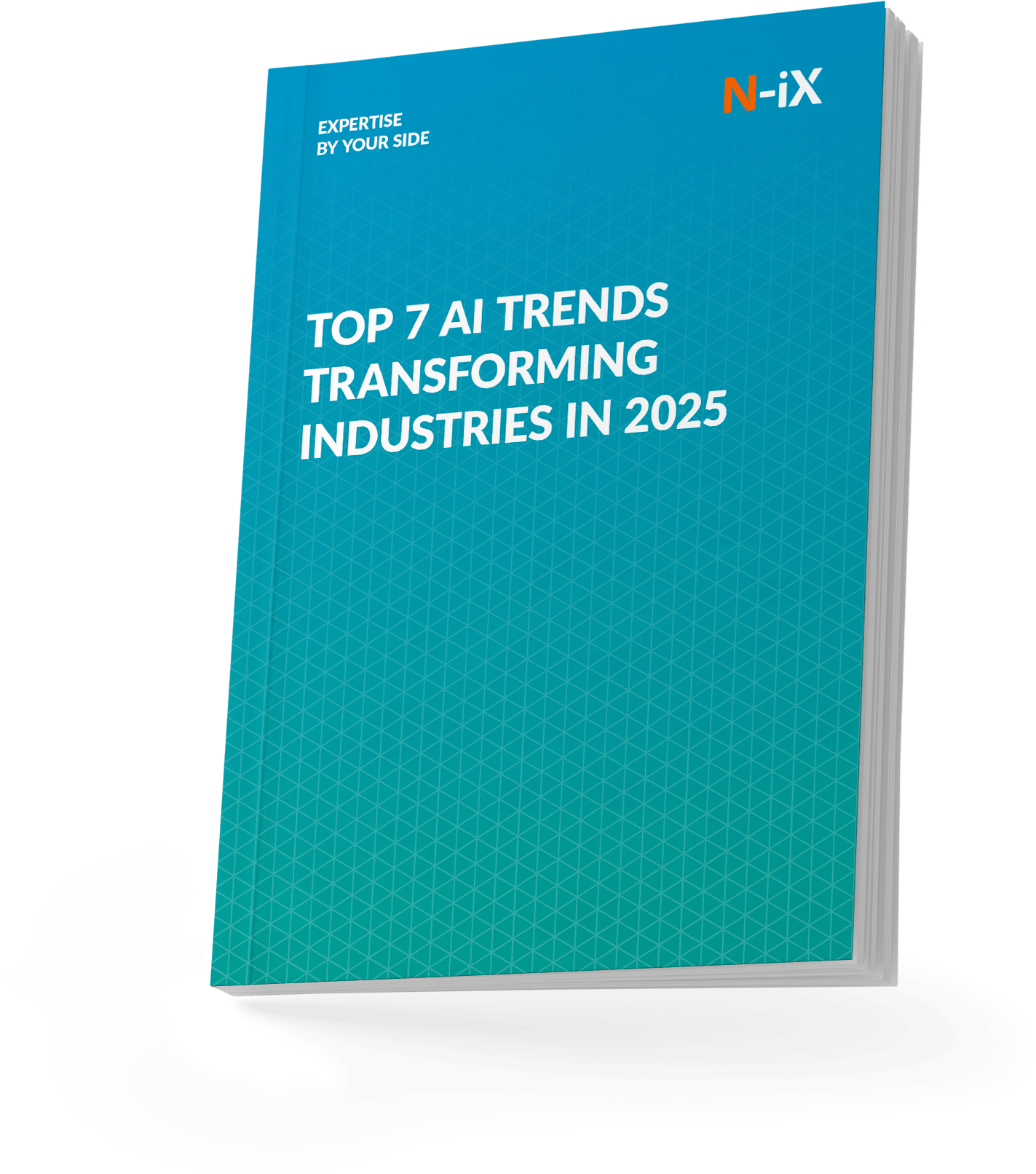Data generation, capture, copying, and consumption will reach over 180 zettabytes by 2025, predicts Statista. While raw data holds potential, it needs transformation to bring insights. Data science services bridge the gap, crafting data engineering systems that collect, store, and deliver meaningful information. Businesses that seek to manage and analyze their data effectively will benefit from exploring 2025's data engineering trends.
6 data engineering trends of 2025
From Large Language Models (LLMs) automating tasks to data hubs facilitating collaboration and democratizing data access, data engineering technologies foster a data-driven culture where organizations can extract maximum value from their assets. Let's take a closer look at the specific data engineering trends in 2025.
1. LLMs will revolutionize data stacks
The data and ML landscape is bracing for a wave of change driven by LLMs. These powerful tools, essentially sophisticated AI models that can understand and generate human language, are set to impact various roles, enhancing efficiency and even creating new roles. LLMs will act as co-pilots for existing data scientists, engineers, and analysts, boosting productivity. Data engineers will gain tools for automating data integration, cleansing, and pipeline generation, while BI engineers can leverage LLMs for optimized queries, complex data analysis, and even answering questions directly.
Beyond these productivity gains, LLMs are paving the way for new roles and capabilities. Application developers can now integrate simple applications with various data sources. This, coupled with the emerging AI engineer role, signifies a shift in applied AI. These engineers will interact with and optimize foundation models, ensuring data quality and building validation systems. Even RevOps and FinOps teams can become more independent, using LLMs for data transformation and direct business insights.
While LLMs have limitations, their potential to automate tasks, assist with knowledge work, and provide new capabilities is undeniable. They promise to empower diverse users, from existing data professionals to AI engineers, and fundamentally reshape the data and ML landscape.
2. RAG will be used to improve the accuracy and value of AI products
Retrieval-augmented generation (RAG) is a technique that improves the accuracy and reliability of GenAI models by incorporating information from external sources. It addresses the limitation of LLMs, which rely solely on internal knowledge, by allowing LLMs to access and cite relevant data from external repositories.
This approach offers several benefits:
- Increased trust: RAG builds trust by enabling models to cite their sources, similar to footnotes in research papers.
- Reduced ambiguity: It helps clarify user queries and minimizes the risk of inaccurate responses or "hallucinations."
- Ease of implementation: RAG can be implemented with minimal code, making it cost-effective and faster than retraining models.
- Broader applications: By connecting with various data sources, RAG opens up new possibilities for conversational experiences across diverse fields.
3. Data observability will be crucial for monitoring and maintaining AI data quality
Constructing accurate and reliable AI models depends on high-quality data. Traditional data monitoring tools often fail to keep pace with the complexities of AI data, often leading to biases, inaccuracies, and even malfunctioning systems. Here's where data observability steps in. This proactive approach continuously analyzes data throughout its lifecycle, identifying potential issues before they impact AI models. It goes beyond simple accuracy checks, examining dimensions like completeness, freshness, and lineage, providing a complete data health assessment. By delivering actionable insights into root causes and remediation strategies, data observability empowers teams to address problems proactively, minimizing rework and streamlining the AI development process.
Benefits include improved model performance through accurate data, reduced development time by avoiding data-related roadblocks, and enhanced trust in AI systems thanks to increased transparency and explainability. Additionally, data observability helps organizations avoid the financial and reputational risks associated with poor data quality, a factor becoming increasingly critical as companies invest more heavily in AI.
Among data engineering trends, data observability offers a comprehensive and proactive approach to data management, serving as the cornerstone for building reliable and trustworthy AI systems. As the reliance on AI grows, so does the need for robust data observability solutions to ensure its success.
4. DataOps: merging engineering with data science
DataOps has emerged as a powerful force in breaking down the traditional silos between data producers and consumers. Inspired by the collaborative spirit of DevOps, it leverages a continuous feedback loop (DataOps lifecycle) to streamline data delivery, ensure data quality, and foster collaboration between data teams and stakeholders. This continuous monitoring (data observability) of data health (freshness, distribution, lineage) allows DataOps to proactively identify and resolve issues, leading to faster deployment of reliable data pipelines and unlocking the full potential of an organization's data assets.

But DataOps is much more than just breaking down silos and fostering collaboration. It's bridging the gap between engineering and data science in exciting ways:
- DataOps fosters close collaboration between data engineers and data scientists to build robust pipelines. Data engineers leverage automation like testing frameworks and monitoring tools, while data scientists bring their expertise in data understanding and quality metrics. This combined approach minimizes human error and ensures high-quality data throughout the pipeline.
- DataOps frees up valuable time for data engineers and data scientists by automating repetitive tasks like data extraction and transformation. This reduces technical debt and aligns their goals—engineers focus on building efficient pipelines while scientists explore advanced analytics.
- DataOps is a common ground for engineers and scientists, eliminating communication barriers and fostering collaboration. They work together to design, build, and monitor pipelines, leading to faster development cycles and quicker generation of insights. This translates to cost savings, faster data-driven decision-making, and a competitive edge.
- As data becomes more accessible, ethical, technical, and legal challenges arise. DataOps, with its data observability tools, provides comprehensive visibility into data usage, flows, and access. This transparency empowers engineers and scientists to comply with regulations, mitigate risks associated with data misuse, and build trust within the organization.
By fostering collaboration between engineering and data science, DataOps unlocks the true potential of an organization's data assets, empowering data-driven decision-making with greater confidence and agility.
5. Data vault: a powerhouse for data lake modeling
Data lakes are redefining data analytics, but managing the vast amount of structured data within them can be challenging. In a data lake environment, data vaults focus on flexibility and auditability, integrating different data sources while tracking every change. The optimal choice hinges on your needs: data lakes shine for exploratory analysis, data warehouses excel in historical analysis, and data vaults offer flexibility and auditability for diverse use cases within a data lake environment.

The data vault modeling technique unlocks several advantages that make it a perfect fit for data lake environments:
- Flexibility: The data vault thrives on agility. Its adaptable structure lets you seamlessly integrate new data sources, cater to diverse use cases, and support parallel development teams. This is crucial when new information sources emerge constantly, and business needs evolve rapidly.
- Efficiency at scale: The data vault enables fast data loading, ensuring your analysts have timely access to insights. This is especially valuable in data lakes, where massive datasets are the norm. No more waiting around for data—get straight to uncovering valuable trends and patterns.
- Trustworthy and transparent: The data vault prioritizes data integrity. Its auditability features track every change made to data entries, fostering trust and transparency in your data ecosystem. It is vital for confidently making informed decisions and ensuring the reliability of your insights.
Amid shifting data engineering trends, the data vault modeling technique stands out for its adaptability and transparency within data lake environments. By prioritizing data integrity and offering auditability features, data vaults allow organizations to meet their business needs while maintaining data reliability.
6. Data hub: building a center of data exchange
Managing your organization's data can be complex, but data hub architecture offers a centralized solution. Acting as a hub for data exchange, it facilitates seamless communication between data producers and consumers, both in real-time and batch processing. This translates into several key benefits:
- Unified view: A data hub establishes a single source of truth, providing a unified perspective on your data across the organization.
- Enhanced security: Centralized controls ensure data security and compliance, protecting your valuable information.
- Cost efficiency: A streamlined data integration and movement process saves time and money.
- Agile processing: This architecture offers tools for building and managing diverse data integration processes, adapting to your evolving needs.
However, it's essential to understand the differences between the data hub and other data engineering trends like data warehouse. While both handle structured and semi-structured data, data warehouses prioritize historical analysis, optimizing storage for complex queries. In contrast, data hubs focus on real-time data exchange and governance, not optimized for deep historical analysis.
Furthermore, data hubs differ from data mesh, a decentralized approach that distributes data ownership and responsibility across teams. Data hubs emphasize centralized control and governance, while data mesh empowers domain-driven data ownership. Combining these approaches (hybrid architecture) is possible, but challenges like data duplication and increased complexity need careful consideration. Successful data hub implementation requires addressing challenges like application integration, data governance, data observability, and ongoing maintenance.
Explore the AI landscape of 2025—get the guide with top trends!


Success!

Wrap-up
In 2025, data engineering isn't just about individual trends; it's a synergy of automation, collaboration, and robust data management. AI-driven pipelines optimize workflows collaboratively with engineers in data management. Democratization of insights via data hubs empowers non-technical users with BI tools, fostering collaboration and informed decision-making. Real-time insights through data observability enable agile responses, while security and ethics remain integral to responsible data utilization. Choosing the right data engineering partner is crucial for innovation, growth, and informed decisions.
Have a question?
Speak to an expert




